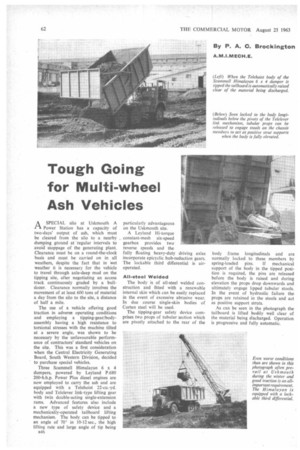Tough Going for Multi-wheel Ash Vehicles
Page 64

If you've noticed an error in this article please click here to report it so we can fix it.
rtA SPECIAL silo at Uskmouth A Power Station has a capacity of two-days' output of ash, which must be cleared from the silo to a nearby dumping ground at -regular intervals to avoid stoppage of the generating plant. Clearance must be on a round-the-clock basis and must be carried on in all weathers, despite the fact that in wet weather it is necessary for the vehicle to travel through axle-deep mud on the tipping site, after negotiating an access track continuously graded by a bulldozer. Clearance normally involves the movement of at least 600 tons of material a day from the silo to the site, a distance of half a mile.
The use of a vehicle offering good traction in adverse operating conditions and employing a tipping-gear/bodyassembly having a high resistance to torsional stresses with the machine tilted at a severe angle, was shown to be necessary by the unfavourable performance of contractors' standard vehicles on the site. This was a first consideration when the Central Electricity Generating Board, South Western Division, decided to purchase special vehicles.
Three Scammell Himalayan 6 x 4 dumpers, powered by Leyland P.680 200-b.h.p. Power Plus diesel engines are now employed to carry the ash and are equipped with a Telehoist 22-cu.-yd. body and Telelever link-type lifting gear with twin double-acting single-extension rams. Advanced features also include a new type of safety device and a mechanically-operated tailboard lifting mechanism. The body can be tipped to an angle of 70° in 10-12 sec., the high lifting rate and large angle of tip being n46 particularly advantageous on the Uskmouth site.
A Leyland Hi-torque constant-mesh six-speed gearbox provides two reverse speeds and the fully floating heavy-duty driving axles incorporate epicyclic hub-reduction gears. The lockable third differential is airoperated.
All-steel Welded The body is of all-steel welded construction and fitted with a renewable internal skin which can be easily replaced in the event of excessive abrasive wear. In due course single-skin bodies of Corten steel will be used.
The tipping-gear safety device comprises two props of tubular section which are pivotly attached to the rear of the body frame longitudinals and are normally locked to these members by spring-loaded pins. If mechanical support of the body in the tipped position is required, the pins are released before the body is raised and during elevation the props drop downwards and ultimately engage lipped tubular stools. In the event of hydraulic failure the props are retained in the stools and act as positive support struts.
As can be seen in the photograph the tailboard is lifted bodily well clear of the material being discharged. Operation is progressive and fully automatic.




































































































